Finally, An Environmental Software Suite that Works Together
[sc_vimeo width=”640″ height=”360″ aspect_ratio=”16:9″ video_id=”876102756″ style=”default” position=”right”]
This week, Vice President of Data Management and Visualization, Todd Pierce is diving into the synergy that exists among our suite of Locus applications. When combined, these four powerful tools—EIM, Locus Platform, GIS+, and Locus Mobile—work seamlessly to help you harness the true potential of your data within the Locus Cloud.
Let’s take a closer look at how each of these applications contributes to transforming your data landscape, click the video to learn more.
[sc_button link=”https://vimeo.com/876102756″ text=”Watch the video” link_target=”_self” color=”000000″ background_color=”52a6ea”]
Request a demo
Send us your contact information and a Locus representative will be in touch to discuss your organization’s needs and provide an estimate, or set up a free demo of our enterprise environmental software solutions.
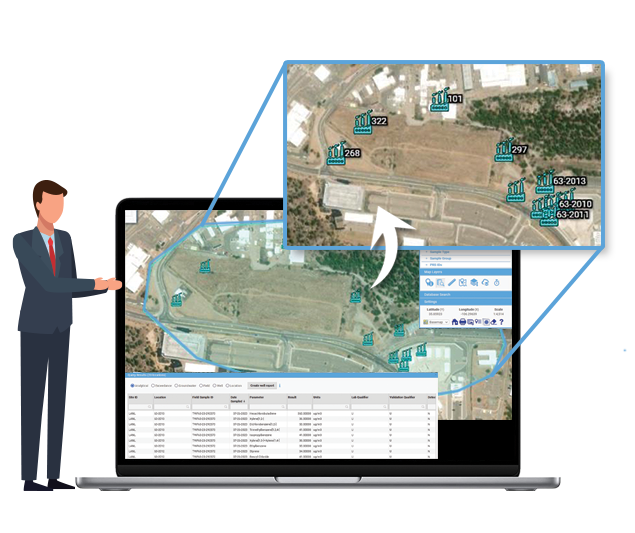
GeoBI
Business intelligence (BI) is a critical component of any organization. BI lets you analyze data on your processes and products, so you have the information needed to make decisions and take actions to improve your business’s performance. BI applications have been available for several years, with offerings from many companies including Microsoft, Oracle, SAS, Qlik, and Tableau.
Initially, BI was focused on just a few areas such as finance, logistics, and sales. As BI effectiveness evolves you need information covering all aspects of your business. One key information set is spatial information, which is usually managed in a geographic information system (GIS). GIS applications have been available since 1965 but only became widely commercially available in the 1980s when ESRI released its first GIS applications. Since then, GIS has spread from the desktop to mobile devices and the cloud.
Often, an organization’s spatial data is separate from other data, kept in its own department or application. For example, your organization might have a GIS department that manages geographic information for your facilities. However, spatial data might also be in other departments such as sales (locations of clients); physical plant (buildings, infrastructure, assets); logistics (sales or delivery routes), or even human resources (safety incident locations). It can be challenging to bring together these disparate spatial data sources and integrate them with non-spatial data stored in spreadsheets, databases, files, and other data warehouses.
Several recent business trends, however, have made it much easier to bring together both spatial and non-spatial information to support GeoBI or Geographic Business Intelligence. First, the rise and ubiquity of the internet ‘cloud’ has made it possible for an organization to put all their data into the cloud. Your business staff can now access all your data, regardless of the physical location of the data or your staff. Second, GIS has evolved from its earlier days when it was a way to automate traditional cartography. Now, GIS supports advanced spatial analysis and visualization techniques, including buffering, contouring, interpolation, network analysis, and 3D mapping. And third, new applications and methods have broken the barriers between spatial and non-spatial data. GeoBI software applications can manage both types of data, letting you combine all your data for analysis and visualization. Applications that don’t explicitly support both types can be connected through the use of application programming interfaces (APIs) for seamless transfer of data.
GeoBI and Locus
Locus Technologies has been a leader in bringing GeoBI to environmental data management. Locus’ software supports non-spatial data analysis via reporting, charting, and expert query functionality. The Locus GIS+ add-on lets you add spatial data to your analysis with the GIS+ functions for spatial query, data classification, time series analysis, buffering, and contouring. Let’s look at some examples.
- Water quality: Clean water regulations may require your facility to identify and report any instances of chemical concentrations in water sources that are above certain action limits. To do this, you can load analytical results from chemical sampling into the application. Once the data is loaded, you can add the sampling results to the GIS+ along with overlays of plant assets, watersheds, aquifers, and other relevant geographic information. You can quickly generate maps showing concentrations at sample locations. In this way, you can identify ‘hotspots’ where your facility may be in non-compliance with regulatory requirements.
The example below shows the GIS+ displaying tritium results from water samples along with watershed boundaries. The map represents each location with a symbol that is colored and sized to reflect the actual maximum value at that location. You can easily see spatial patterns and identify two areas of concern near the center of the map – one with orange and yellow circles, and another with red circles. You could then use other functions, such as charting or contouring, to further explore the results at these locations.
- Air quality: Your facility may fall under clean air regulations such as the US EPA’s 40 CFR Part 60 Subpart OOOO standards. In short, this subpart establishes emission standards and compliance schedules for the control of volatile organic compounds (VOC) and sulfur dioxide (SO2) emissions). As an environmental manager, you could simply use a BI program to write and run a text query such as “show me all emission assets that have exceedances under 40 CFR Part 60 Subpart OOOO”.
However, Subpart OOOO often applies to the Oil and Gas industry where maps and GIS are heavily utilized. If you have data and maps, you can associate a data query to an area that is “lassoed” on the map. The example below shows several emission sites that have been grouped together by a user-drawn area. Locus shows a table of all data for the “lassoed” locations, including analytical results and regulatory exceedances. By simply putting a lasso around another set of emission locations, the query is automatically updated with the relevant results. No query needs to be written – you just need to lasso locations on a map!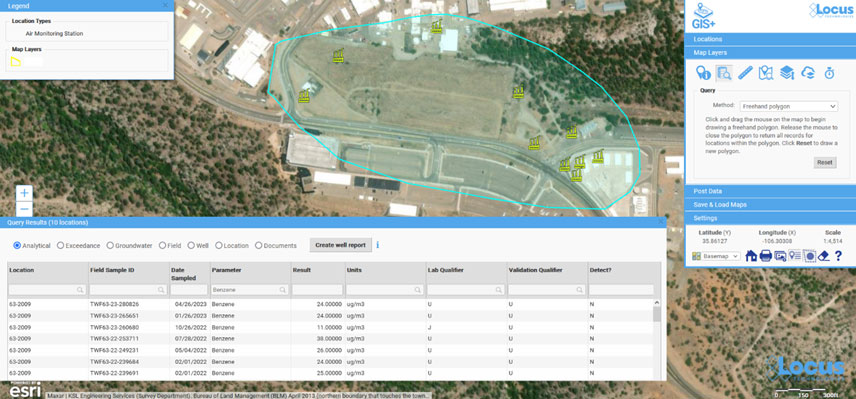
- Safety: In a similar fashion, safety personnel can use a map to find different incident categories without having to train on reporting and query details. When an incident occurs, efficiency of logging the essential information is paramount, and simple pulldown list coupled with graphics expedite the process when time is of the essence.
Below is a map where the manager and incident for rapid input was pinned to a location and for follow-up on a particular region the manager can apply a lasso query to list all Significant Injuries and Fatalities (SIFs), for root cause and other analysis.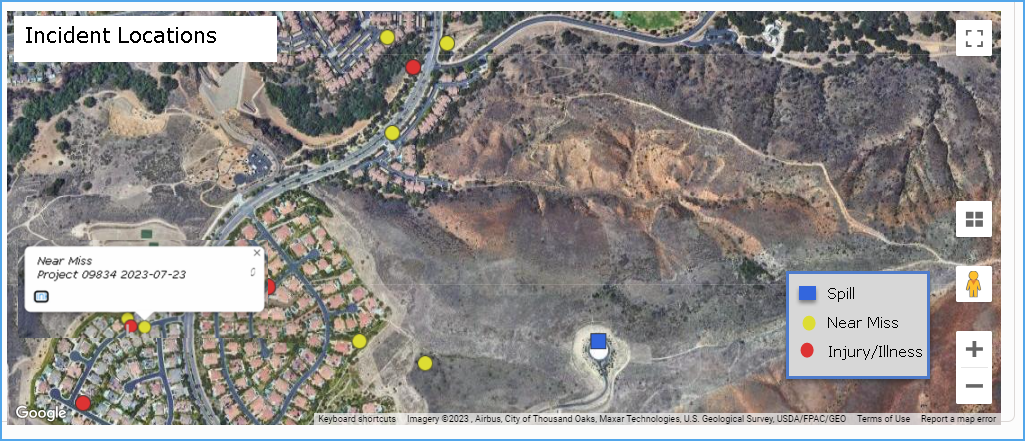
GeoBI and You
The above examples show how GeoBI can bring all your data together for use in analysis and decision-making, leading to a more complete picture of your facilities and processes. Furthermore, by having one suite of applications for your GeoBI needs, your organization can be more efficient. If spatial and non-spatial data are in separate silos, accessible only by different staff, it is difficult for one person to perform a complete analysis. Files, maps, spreadsheets, and other data objects must be shuffled between different persons and applications. With your data in Locus software, a full GeoBI analysis can be performed by one person, leading to productivity gains and cost reductions.
In the future, advances in artificial intelligence (AI) could lead to GeoAI, which would combine GeoBI with powerful features such as predictive analytics, pattern mining, and anomaly detection. Stay tuned for a future blog post on these exciting possibilities!
Acknowledgments: All the data used in the examples was obtained from the publicly available chemical datasets online at Intellus New Mexico.
Want to learn more about Locus Software Solutions? Reach out to our product specialists today!
MOUNTAIN VIEW, Calif., 14 February 2023 — Locus Technologies, the leading EHS Compliance, and ESG software provider, today announced that San Jose Water (SJW), an investor-owned public utility providing water service to a population of approximately one million people in the Santa Clara Valley, has expanded Locus’ environmental information management software to use Locus GIS+ for advanced GIS analysis.
SJW has been using Locus SaaS and mobile app since 2014 to manage its field data collection, water quality compliance, and regulatory reporting. SJW also uses Locus to track sewer discharges and well blow-offs.
“Our responsibility is to ensure our customers receive the highest quality drinking water from their taps. We monitor the quality and cleanliness of our water in terms of state and federal regulatory requirements. In 2021, our highly experienced staff collected more than 1,000 regulatory and non-regulatory samples from our distribution system and treatment plant, generating over 23,000 data points. To manage this data effectively, we used Locus’ cloud-based software. GIS mapping capabilities are essential for our environmental data analysis. Locus GIS+ will allow quick data visualization and is a quantum leap forward with advanced analysis tools that use Esri’s Smart Mapping technology,” said Suzanne DeLorenzo, the Director of Water Quality at San Jose Water.
“Locus’s mission is to help organizations, such as San Jose Water, to achieve their business goals by providing them the software tools to manage key data associated with water quality and compliance reporting,” said Neno Duplan, CEO of Locus. “With GIS+, SJW will have all the tools they need to perform a wide range of geospatial data analysis across their distribution system. Our water quality management cloud-based software, coupled with GIS+ and Locus Mobile for field data collection, provides our customers with a highly scalable and feature-rich application that gives water utilities strong analytical power and advanced GIS capabilities.”
Locus GIS+ is powered by Esri’s ArcGIS platform and offers various advanced features— including enhanced cartography, comprehensive spatial data analysis, and the ability to use the customer’s map data through integration with ArcGIS Online and Portal for ArcGIS.
ABOUT SAN JOSE WATER
Founded in 1866, San Jose Water is an investor-owned public utility and is one of the largest and most technically sophisticated urban water systems in the United States. Serving over one million people in the greater San Jose metropolitan area, San Jose Water also provides services to other utilities, including operations and maintenance, billing, and backflow testing. San Jose Water is owned by SJW Group, a publicly-traded company listed on the New York Stock Exchange under the symbol SJW. SJW Group also owns Connecticut Water Company in Connecticut; Maine Water Company in Maine; and SJWTX, Inc. (dba Canyon Lake Water Service Company) in Texas. To learn more about San Jose Water, visit www.sjwater.com.
2022 has given us a wealth of new features and growth! Both of our platforms have undergone improvements to enhance our client’s user experience. Let’s look at all the new features for 2022.
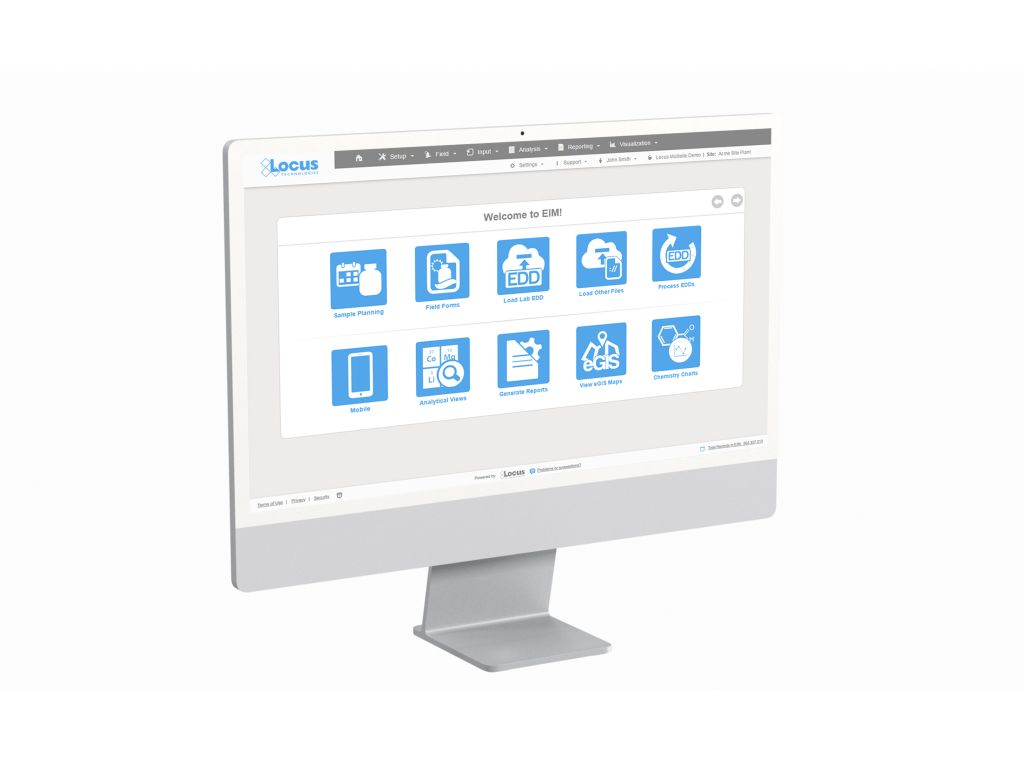
Environmental Information Management (EIM)
[sc_icon_with_text icon=”mapping” icon_shape=”circle” icon_color=”#ffffff” icon_background_color=”#52a6ea” icon_size=”big” level=”h3″]
1. New Site Metrics dashboard allows immediate visibility into your data with clickable mapping. This is especially powerful for customers with multiple sites where they want to keep track of site activity and usage. [/sc_icon_with_text]
[sc_icon_with_text icon=”multisite-view” icon_shape=”circle” icon_color=”#ffffff” icon_background_color=”#9ac63f” icon_size=”big” level=”h3″]
2. Finding data can sometimes be overwhelming especially when you have hundreds, if not thousands, of locations and numerous analytical parameters to review. Locus added advanced database search tools to support multiple search terms and ‘exact match’ searches, making it easy to find exactly what you want with a couple of key words and a click. Never has finding the right results from large complex datasets been so easy. [/sc_icon_with_text]
[sc_icon_with_text icon=”integration-service” icon_shape=”circle” icon_color=”#ffffff” icon_background_color=”#3766b5″ icon_size=”big” level=”h3″]
3. Locus has enhanced its API functionality to enable easier integration with external BI tools, including Tableau, PowerBI, and other apps. Now, customers that rely on external business analytical tools will have quick and easy access to data to combine with other internal data sources. [/sc_icon_with_text]
[sc_icon_with_text icon=”locus-docs” icon_shape=”circle” icon_color=”#ffffff” icon_background_color=”#52a6ea” icon_size=”big” level=”h3″]
4. Locus document management has been taken to the next level by allowing customers to link documents from any external library directly into their sites, monitoring locations, samples, and more. This means with a simple click, users can go to lab reports, regulatory reports, and any other current or historical document associated with the site. If you are using SharePoint, for example, to manage documents – they can be accessed directly from Locus software. Document access and security will be preserved by existing document library access controls. [/sc_icon_with_text]
[sc_icon_with_text icon=”help” icon_shape=”circle” icon_color=”#ffffff” icon_background_color=”#9ac63f” icon_size=”big” level=”h3″]
5. 2022 was the year of “help”. In addition to the advanced search, Locus added a new Help Browser to provide access to comprehensive documentation for every feature of the software. It is similar to the familiar “site map”, only the links take you to help content. With this new feature, users can view help in a single location vs having to access the information on each individual screen. For new users, or infrequent users, this will be their new favorite feature. [/sc_icon_with_text]
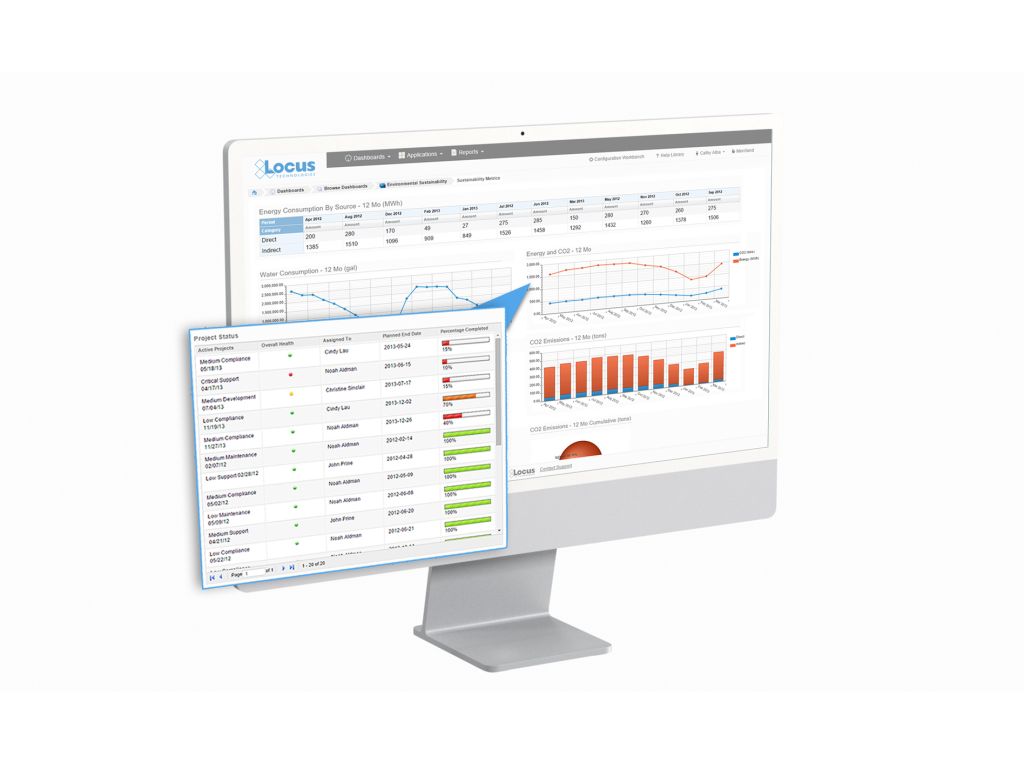
EHS & ESG Solutions
[sc_icon_with_text icon=”material-consumption” icon_shape=”circle” icon_color=”#ffffff” icon_background_color=”#52a6ea” icon_size=”big” level=”h3″]
1. Locus’ Survey/Questionnaire tool enables you to securely & easily obtain data globally without the burdens of training or maintaining user lists. The survey system effortlessly supports data entry from external organizations (such as suppliers) or even occasional users internal to your organization, with a simple link click. [/sc_icon_with_text]
[sc_icon_with_text icon=”drag-up–down” icon_shape=”circle” icon_color=”#ffffff” icon_background_color=”#9ac63f” icon_size=”big” level=”h3″]
2. Locus released a new pivot table tool that enables you to perform full data analysis on any query in the system. Data may be grouped and organized by any value. Output options include bar charts, heatmaps, tables, area charts, scatter charts, and tree maps. In support of the output options, Locus has improved the ability for users to create dashboards more easily. [/sc_icon_with_text]
[sc_icon_with_text icon=”audit” icon_shape=”circle” icon_color=”#ffffff” icon_background_color=”#3766b5″ icon_size=”big” level=”h3″]
3. Complex inspection and audit forms require branching, sophisticated, scoring, and automated responses. Locus added new question types to its inspection/ audit module, including conditional questions based on responses to one or more previous questions. Locus augmented the scoring calculation mechanism and automated creation and tracking of corrective action. [/sc_icon_with_text]
[sc_icon_with_text icon=”tasks” icon_shape=”circle” icon_color=”#ffffff” icon_background_color=”#52a6ea” icon_size=”big” level=”h3″]
4. In today’s world, users need access to environmental data on the go. Locus augmented its mobile offerings to include configurable layouts for mobile users, with compact forms specially designed for smartphone and tablet access. [/sc_icon_with_text]
[sc_icon_with_text icon=”manage-entities” icon_shape=”circle” icon_color=”#ffffff” icon_background_color=”#9ac63f” icon_size=”big” level=”h3″]
5. Today’s managers want immediate access to the data they need. Locus’ new Landing Page feature makes it simple to configure the dashboards, bookmarks, and record lists. This enables the user to review just the areas they need to see and navigate efficiently to complete the work. [/sc_icon_with_text]
Contact us to see a demo of Locus software and get a quote
Today is GIS Day, a day started in 1999 to showcase the many uses of geographical information systems (GIS). Earlier Locus blog posts have explained how GIS and maps support visualization of objects in space and over time. This post covers a specific visualization method called data dashboards.
A data dashboard is a combination of charts, maps, text, and images that enables analysis of data and thereby promotes discovery of previously unknown relationships in the data. Companies and organizations use dashboards to develop insight into the overall status of a company or of a company division, process, or product line. Dashboards are also a common function in ‘business intelligence’ applications such as Microsoft Power BI and Tableau. A printed dashboard is static, but an online dashboard can be dynamic; in a dynamic dashboard, interacting with one item on the dashboard causes the other items to update. Taken together, the visualizations on a dynamic dashboard can help you find the story in your data.
One reason dashboards are so helpful is that they allow humans to partially ‘offload’ their thinking. Cognitive research has shown that human ‘working memory’ handles at most four items at a time. A good visualization, however, reduces the number of items to process in memory.
Consider a large table of carbon dioxide emissions by country for multiple years; it can be difficult to keep all the numbers in mind if you are trying to find trends.

If you plot the data in a graph, however, each series of data in the chart becomes just one line on the graph. It is much easier to compare lines on the chart than to compare columns of numbers.

Now consider making a map with countries color coded by emissions. Again, for each country, the map reduces multiple numbers to a single color for that country on the map. You can compare country colors more easily than columns of numbers.

A dashboard that combines multiple visualizations further enhances data analysis. Imagine a dynamic dashboard showing you both the emissions chart and map described above. If you select a country on the map, the chart can highlight the line for that country, so you compare its emissions to other countries over time. Similarly, if you select a line on the chart for a specific country, the map can highlight the selected country to show how its emissions compare to nearby countries. This interactivity lets you drill into your data more effectively than using either the chart or the map by itself.
Here are three examples of effective dashboards that are available online:
- The Covid-19 dashboard from John Hopkins shows a map, charts, and tables of Covid -19 cases.
- The Global Climate Dashboard from NOAA shows charts of multiple climate indicators.
- The Carbon Pricing dashboard from the World Bank lets you drilldown to see carbon pricing initiatives for various nations.
Locus includes data dashboards in our applications. One example is the Site Metrics dashboard in EIM, Locus’s cloud-based, software-as-a-service application for environmental data management. The Site Metrics dashboard lets you perform roll-up queries across your portfolio of sites. A map on the dashboard shows all states with active sites. If you select one or more states, the dashboard updates the charts and tables on the right to show total sites, user logins, and record counts. Other dashboards can support showing sample locations of certain chemicals or counts of regulatory limit exceedances.

A further example comes from the Locus Environmental Social and Governance (ESG) application. ESG metrics are becoming increasingly important measures for an organization’s performance. Data dashboards can help companies quickly visualize trends in their ESG metrics using intuitive mapping tools.

This dashboard illustrates both spatial and time trends and provides the raw data necessary for auditability and transparent decision making. Having these features on a single combined view provides users with instant access to the key inputs for ESG prioritization, planning, and project implementation.
As these examples from Locus show, data dashboards with integrated mapping are important tools for maximizing the value of your collected environmental and ESG data. For any dataset with a geographic component, it’s important to incorporate mapping elements in the outputs, to highlight trends and patterns that may not otherwise be visible in a chart or table. Modern software can combine these output formats in a way that tells the story shown by your data.
Interested in Locus’ GIS solutions?
Locus GIS+ features all of the functionality you love in EIM’s classic Google Maps GIS for environmental management—integrated with the powerful cartography, interoperability, & smart-mapping features of Esri’s ArcGIS platform!
[sc_button link=”https://www.locustec.com/applications/gis-mapping/” text=”Learn more about Locus’ GIS solutions” link_target=”_self” color=”#ffffff” background_color=”#52a6ea” centered=”1″]
[sc_image width=”150″ height=”150″ src=”16303″ style=”11″ position=”centered” disable_lightbox=”1″ alt=”Dr. Todd Pierce”]
About the Author—Dr. Todd Pierce, Locus Technologies
Dr. Pierce manages a team of programmers tasked with development and implementation of Locus’ EIM application, which lets users manage their environmental data in the cloud using Software-as-a-Service technology. Dr. Pierce is also directly responsible for research and development of Locus’ GIS (geographic information systems) and visualization tools for mapping analytical and subsurface data. Dr. Pierce earned his GIS Professional (GISP) certification in 2010.
The Past, Present, and Future of EHS & ESG
To celebrate a milestone 25 years of success in EHS and ESG software development, we sat down with Locus President, Wes Hawthorne for a brief discussion. In this post, we ask him a series of questions highlighting the past, present and future of EHS and ESG.
1. What are the greatest challenges that environmental professionals are facing?
One of the persistent challenges we’ve seen for the past 25 years is that the responsibilities of environmental professionals are continually expanding. Previously, almost all environmental work was localized, with facility-level permits for air, water, waste, etc. That has expanded over the years to include new regulations and reporting requirements for sustainability, social metrics, and other new compliance areas, while the old facility-level programs still continue. This has led to more pressure on environmental managers to keep up with these programs, and increased reliance on tools to manage that information. That’s where Locus has always focused our effort, to make that ever-expanding workload more manageable with modern solutions.
2. What are the most interesting trends in EHS and ESG?
The current flood of interest in ESG is certainly notable as far as bringing corporate attention to the environmental field, as well as having requirements originate from the SEC here in the US. We have become accustomed to managing oversight from multiple regulatory bodies at the local, state, and federal level, but SEC would be a newcomer in our line of work. Their involvement will be accompanied by a range of new requirements that are common for the financial world, but would be unfamiliar to environmental staff.
Across other EHS fields, we are seeing increased demand for transparency in EHS functions. Overall, this is a positive move, as it brings more attention to EHS issues and develops a better EHS culture within organizations. But this also drives the need for better tools to make EHS information readily available across all levels of the organization.
3. What are the most disruptive technologies available today?
As far as technologies, the ones most likely to have significant impact in the environmental field are ones that don’t require a significant capital investment. Although there are definitely some practical advantages to installing smart monitoring devices and other new technologies, procuring the funding for those purchases is often difficult for environmental professionals. Fortunately, there are still many technologies that have already been implemented successfully in other fields, but only need to be adapted for environmental purposes. Even simple changes like using web-based software in place of spreadsheets can have a huge impact on efficiency. And we haven’t yet seen the full impact of the proliferation of mobile devices on EHS functions. We are still working on new ways to take advantage of mobile devices for data collection, analysis, and communication purposes.
4. What do you think are the biggest innovations of the last 25 years in our field?
We’ve seen a number of innovation milestones in the past 25 years, and while we didn’t invent SaaS, we’ve been largely responsible for adapting it and perfecting it for environmental purposes. One of the major innovations we’ve integrated into our products include online GIS tools where users can easily visualize their environmental data on maps without expensive desktop software. Another one was our fully configurable software platform with built-in form, workflow, and report builders tailored for environmental purposes, which allows anyone to build and deploy environmental software applications that exactly match their needs. There have been many other innovations we’ve incorporated into our software, but these two stand out as the most impactful.
5. Where do you see Environmental and ESG reporting in the future?
More and more, we are seeing all types of reporting being converted into pure data exchanges. Reports that used to include regulatory forms and text interpretations are being replaced with text or XML file submittals. This transition is being driven largely by availability of technology for EHS professionals to generate and read these files, but it is also promoted by regulatory agencies and other stakeholders receiving these reports. Stakeholders have less time to read volumes of interpretive text, and are becoming more skeptical of potential bias in how facts are presented in text. These are driving the need for more pure data exchanges, with increasing emphasis on quantifiable metrics. These types of reports are also more readily compared against regulatory or industry standards. For reporters, lengthy corporate reports with volumes of text and graphics are becoming less common, and the success of an organization’s programs will be increasingly reliant on robust data sets, since ultimately only the data will be reported.
6. What has been the key reason for Locus’ success for the past 25 years?
There are actually a few that immediately come to mind. One reason is the nature of our continually evolving products. By providing our solutions as SaaS, our software adapts with new environmental requirements, and with new technologies. If our software was still the same as it was 25 years ago, it simply wouldn’t be sufficient for today’s requirements. Since our software is updated multiple times each year, it is difficult to notice the incremental changes, but they can be readily seen if you compare today’s software with the original in 1997. And we’re committed to continuing the development of our products as environmental needs change.
The other primary reason for our success is our excellent staff and the environmental expertise we bring to our customers. We simply could not provide the same level of support without our team of environmental engineers, scientists, geologists, chemists, and an array of others. Having that real-world understanding of environmental topics is how we’ve maintained customer relationships for multiple decades. And our software only has value because it is maintained and operated by staff who appreciate the complexity and importance of environmental work.
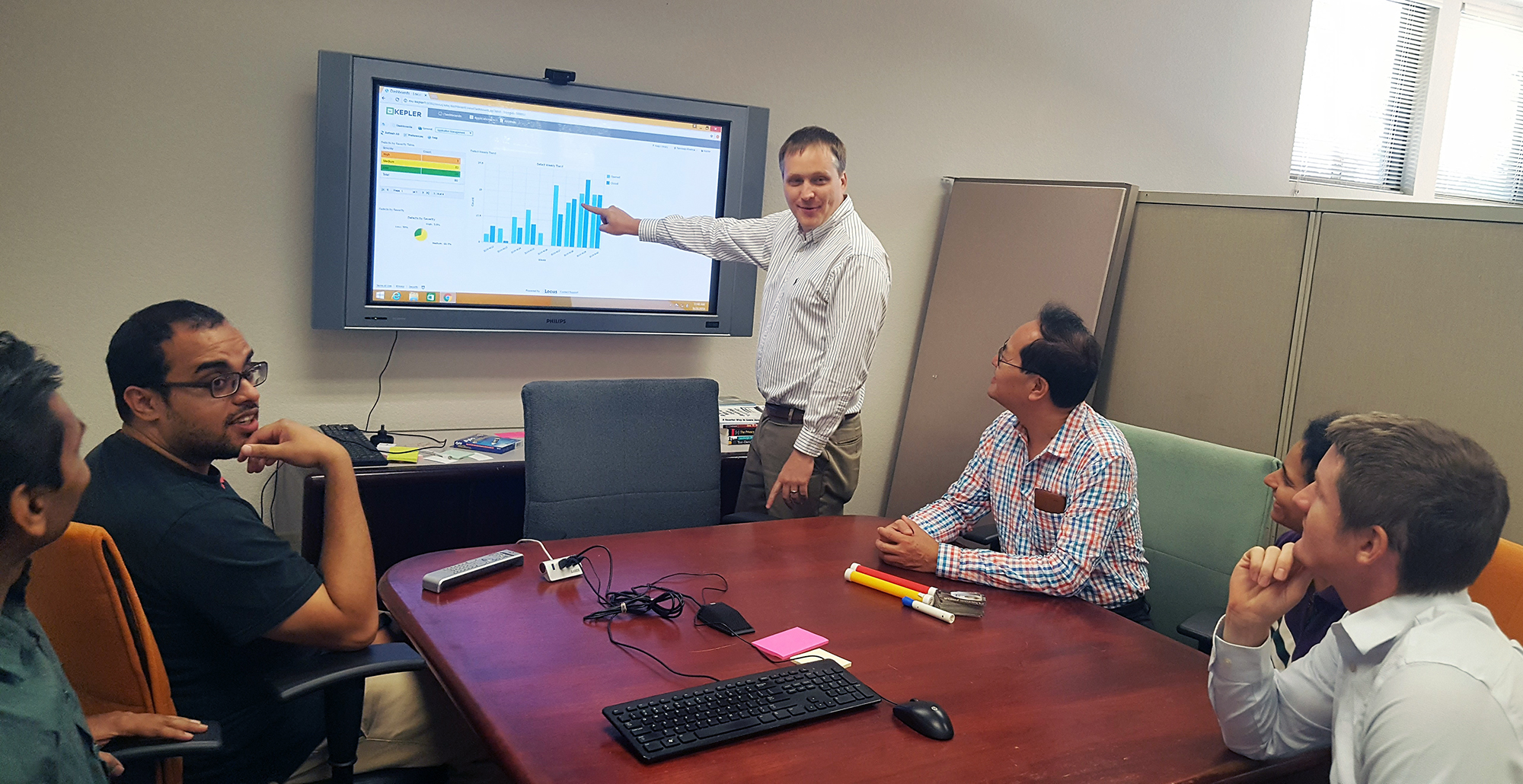 Mr. Hawthorne has been with Locus since 1999, working on development and implementation of services and solutions in the areas of environmental compliance, remediation, and sustainability. As President, he currently leads the overall product development and operations of the company. As a seasoned environmental and engineering executive, Hawthorne incorporates innovative analytical tools and methods to develop strategies for customers for portfolio analysis, project implementation, and management. His comprehensive knowledge of technical and environmental compliance best practices and laws enable him to create customized, cost-effective and customer-focused solutions for the specialized needs of each customer.
Mr. Hawthorne has been with Locus since 1999, working on development and implementation of services and solutions in the areas of environmental compliance, remediation, and sustainability. As President, he currently leads the overall product development and operations of the company. As a seasoned environmental and engineering executive, Hawthorne incorporates innovative analytical tools and methods to develop strategies for customers for portfolio analysis, project implementation, and management. His comprehensive knowledge of technical and environmental compliance best practices and laws enable him to create customized, cost-effective and customer-focused solutions for the specialized needs of each customer.
Mr. Hawthorne holds an M.S. in Environmental Engineering from Stanford University and B.S. degrees in Geology and Geological Engineering from Purdue University. He is registered both as a Professional Engineer and Professional Geologist, and is also accredited as Lead Verifier for the Greenhouse Gas Emissions and Low Carbon Fuel Standard programs by the California Air Resources Board.
Want to discuss EHS and ESG solutions with our product specialists? Contact us today!
Locus Technologies
299 Fairchild Drive
Mountain View, CA 94043
P: +1 (650) 960-1640
F: +1 (415) 360-5889
Locus Technologies provides cloud-based environmental software and mobile solutions for EHS, sustainability management, GHG reporting, water quality management, risk management, and analytical, geologic, and ecologic environmental data management.
